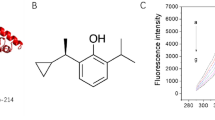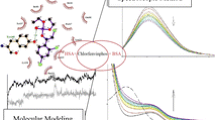Abstract
Purpose
The interaction between triclosan (TCS) and human serum albumin (HSA) was investigated in order to obtain the binding mechanism, binding constant, the type of binding force, the binding distance between the donor and acceptor, and the effect of TCS on the conformation change of HSA.
Methods
A HSA solution was added to the quartz cell and then titrated by successive addition of TCS. The fluorescence quenching spectra and synchronous spectra were recorded with the excitation and emission slits of the passage of band set at 10 and 20 nm. Three-dimensional fluorescence spectra of HSA were recorded before and after the addition of TCS. The capillary electrophoresis was conducted with the pressure injection mode at 0.5 psi for 5 s, separation under 25 kV, and detection at 214 nm.
Results
Fluorescence data indicated the fluorescence quenching of HSA by TCS was static quenching, and the quenching constants (K a ) were 1.14 × 105, 8.75 × 104, 6.67 × 104, and 5.00 × 104 at 293, 298, 303, and 309 K, respectively. The thermodynamic parameters, enthalpy change (ΔH) and entropy change (ΔS) for the interaction were calculated to be −37.9 kJ mol−1 and 32.6 J mol−1 K−1. The binding distance between TCS and tryptophan residues of HSA was obtained to be 1.81 nm according to Fǒrster nonradioactive energy transfer theory. The UV-Vis absorption spectroscopy, the synchronous fluorescence spectroscopy, three-dimensional fluorescence spectroscopy, and circular dichroism spectroscopy revealed the alterations of HSA secondary structure in the presence of TCS. Finally, the interaction between TCS and HSA was further confirmed by capillary electrophoresis.
Conclusions
TCS was bound to HSA to form the TCS-HSA complex, with the binding distance of 1.81 nm. Hydrophobic interaction and hydrogen bond were dominated in the binding. TCS could change the secondary conformation of HSA. This work provides an insight into noncovalent interaction between emerging pollutants and protein, helping to elucidate the toxic mechanism of such pollutants.









Similar content being viewed by others
References
Allmyr M, Harden F, Toms LML, Mueller JF, McLachlan MS, Adolfsson-Erici M, Sandborgh-Englund G (2008) The influence of age and gender on triclosan concentrations in Australian human blood serum. Sci Total Environ 393(1):162–167
Apicella B, Ciajolo A, Tregrossi A (2004) Fluorescence spectroscopy of complex aromatic mixtures. Anal Chem 76(7):2138–2143
Bhattacharya AA, Curry S, Franks NP (2000) Binding of the general anesthetics propofol and halothane to human serum albumin. High resolution crystal structures. J Biol Chem 275(49):38731–38738
Binelli A, Cogni D, Parolini M, Riva C, Provini A (2009) In vivo experiments for the evaluation of genotoxic and cytotoxic effects of triclosan in zebra mussel hemocytes. Aquat Toxicol 91(3):238–244
Braoudaki M, Hilton AC (2004) Low level of cross-resistance between triclosan and antibiotics in Escherichia coli K-12 and E. coli O55 compared to E. coli O157. FEMS Microbiol Lett 235(2):305–309
Daughton CG, Ternes TA (1999) Pharmaceuticals and personal care products in the environment: agents of subtle change? Environ Health Perspect 107:907–938
Ding F, Zhao G, Chen S, Liu F, Sun Y, Zhang L (2009) Chloramphenicol binding to human serum albumin: determination of binding constants and binding sites by steady-state fluorescence. J Mol Struct 929(1–3):159–166
Förster T (1948) Zwischenmolekulare Energiewanderung und Fluoreszenz. Ann Phys 437(1–2):55–75
Gomez FA, Mirkovich JN, Dominguez VM, Liu KW, Macias DM (1996) Multiple-plug binding assays using affinity capillary electrophoresis electrophoresis. J Chromatogr A 727(2):291–299
Hage DS, Austin J (2000) High-performance affinity chromatography and immobilized serum albumin as probes for drug- and hormone-protein binding. J Chromatogr B 739(1):39–54
Heberer T (2002) Occurrence, fate, and removal of pharmaceutical residues in the aquatic environment: a review of recent research data. Toxicol Lett 131(1–2):5–17
Heegaard NHH (2003) Applications of affinity interactions in capillary electrophoresis. Electrophoresis 24(22–23):3879–3891
Horrocks WD, Collier WE (1981) Lanthanide ion luminescence probes. Measurement of distance between intrinsic protein fluorophores and bound metal ions: quantitation of energy transfer between tryptophan and terbium(III) or europium(III) in the calcium-binding protein parvalbumin. J Am Chem Soc 103(10):2856–2862
Kalanur SS, Seetharamappa J, Kalalbandi VKA (2010) Characterization of interaction and the effect of carbamazepine on the structure of human serum albumin. J Pharm Biomed 53(3):660–666
Kathiravan A, Chandramohan M, Renganathan R, Sekar S (2009) Spectroscopic studies on the interaction between phycocyanin and bovine serum albumin. J Mol Struct 919(1–3):210–214
Kolpin DW, Furlong ET, Meyer MT, Thurman EM, Zaugg SD, Barber LB, Buxton HT (2002) Pharmaceuticals, hormones, and other organic wastewater contaminants in US streams, 1999–2000: a national reconnaissance. Environ Sci Technol 36(6):1202–1211
Kookana RS, Ying GG, Waller NJ (2011) Triclosan: its occurrence, fate and effects in the Australian environment. Water Sci Technol 63(4):598–604
Lehrer S (1971) Solute perturbation of protein fluorescence. Quenching of the tryptophyl fluorescence of model compounds and of lysozyme by iodide ion. Biochemistry 10(17):3254–3263
Lin DS, Zhou QX, Xie XJ, Liu Y (2010) Potential biochemical and genetic toxicity of triclosan as an emerging pollutant on earthworms (Eisenia fetida). Chemosphere 81(10):1328–1333
Mahammed A, Gray HB, Weaver JJ, Sorasaenee K, Gross Z (2004) Amphiphilic corroles bind tightly to human serum albumin. Bioconjug Chem 15(4):738–746
Mezcua M, Gomez MJ, Ferrer I, Aguera A, Hernando MD, Fernandez-Alba AR (2004) Evidence of 2,7/2,8-dibenzodichloro-p-dioxin as a photodegradation product of triclosan in water and wastewater samples. Anal Chim Acta 524(1–2):241–247
Nishi I, Kawakami T, Onodera S (2008) Monitoring of triclosan in the surface water of the Tone Canal, Japan. Bull Environ Contam Toxicol 80(2):163–166
Ostergaard J, Heegaard NHH (2003) Capillary electrophoresis frontal analysis: principles and applications for the study of drug-plasma protein binding. Electrophoresis 24(17):2903–2913
Peng X, Yu Y, Tang C, Tan J, Huang Q, Wang Z (2008) Occurrence of steroid estrogens, endocrine-disrupting phenols, and acid pharmaceutical residues in urban riverine water of the Pearl River Delta, South China. Sci Total Environ 397(1–3):158–166
Rahman MH, Maruyama T, Okada T, Yamasaki K, Otagiri M (1993) Study of interaction of carprofen and its enantiomers with human serum albumin—I: mechanism of binding studied by dialysis and spectroscopic methods. Biochem Pharmacol 46(10):1721–1731
Raut SA, Angus RA (2010) Triclosan has endocrine-disrupting effects in male western mosquitofish, Gambusia affinis. Environ Toxicol Chem 29(6):1287–1291
Ross PD, Subramanian S (1981) Thermodynamics of protein association reactions: forces contributing to stability. Biochemistry 20(11):3096–3102
Sabaliunas D, Webb SF, Hauk A, Jacob M, Eckhoff WS (2003) Environmental fate of triclosan in the River Aire Basin, UK. Water Res 37(13):3145–3154
Servos MR, Smith M, McInnis R, Burnison BK, Lee BH, Seto P, Backus S (2007) The presence of selected pharmaceuticals and the antimicrobial triclosan in drinking water in Ontario, Canada. Water Qual Res J Can 42(2):130–137
Singer H, Muller S, Tixier C, Pillonel L (2002) Triclosan: occurrence and fate of a widely used biocide in the aquatic environment: field measurements in wastewater treatment plants, surface waters, and lake sediments. Environ Sci Technol 36(23):4998–5004
Sklar LA, Hudson BS, Simoni RD (1977) Conjugated polyene fatty acids as fluorescent probes: synthetic phospholipid membrane studies. Biochemistry 16(5):819–828
Ware WR (1962) Oxygen quenching of fluorescence in solution: an experimental study of the diffusion process. J Phys Chem 66(3):455–458
Weiss S (1999) Fluorescence spectroscopy of single biomolecules. Science 283(5408):1676–1683
Ying GG, Kookana RS, Kolpin DW (2009) Occurrence and removal of pharmaceutically active compounds in sewage treatment plants with different technologies. J Environ Monitor 11(8):1498–1505
Yoon Y, Ryu J, Oh J, Choi BG, Snyder SA (2010) Occurrence of endocrine disrupting compounds, pharmaceuticals, and personal care products in the Han River (Seoul, South Korea). Sci Total Environ 408(3):636–643
Yu X, Liu R, Yang F, Ji D, Li X, Chen J, Huang H, Yi P (2010) Study on the interaction between dihydromyricetin and bovine serum albumin by spectroscopic techniques. J Mol Struct 985(2–3):407–412
Zhang YZ, Zhou B, Liu YX, Zhou CX, Ding XL, Liu Y (2008) Fluorescence study on the interaction of bovine serum albumin with p-aminoazobenzene. J Fluoresc 18(1):109–118
Zhang YZ, Zhou B, Zhang XP, Huang P, Li CH, Liu Y (2009) Interaction of malachite green with bovine serum albumin: determination of the binding mechanism and binding site by spectroscopic methods. J Hazard Mater 163(2–3):1345–1352
Zhang HM, Chen J, Zhou QH, Shi YQ, Wang YQ (2010) Study on the interaction between cinnamic acid and lysozyme. J Mol Struct 987(1–3):7–12
Zhao JL, Ying GG, Liu YS, Chen F, Yang JF, Wang L (2010) Occurrence and risks of triclosan and triclocarban in the Pearl River system, South China: from source to the receiving environment. J Hazard Mater 179(1–3):215–222
Acknowledgments
We sincerely thank the National Natural Science Foundation of China (41072172), State Key Laboratory of Pollution Control and Resource Reuse (Tongji University), China (no. PCRRY 11001), the Transformation Fund for Agricultural Science and Technology Achievements of the Ministry of Science and Technology, China (2010GB23600672), and the Research Foundation of Shanghai Committee of Science and Technology (10595312500) for financially supporting this work.
Author information
Authors and Affiliations
Corresponding author
Additional information
Responsible editor: Philippe Garrigues
Rights and permissions
About this article
Cite this article
Chen, J., Zhou, X., Zhang, Y. et al. Binding of triclosan to human serum albumin: insight into the molecular toxicity of emerging contaminant. Environ Sci Pollut Res 19, 2528–2536 (2012). https://doi.org/10.1007/s11356-012-0901-5
Received:
Accepted:
Published:
Issue Date:
DOI: https://doi.org/10.1007/s11356-012-0901-5




